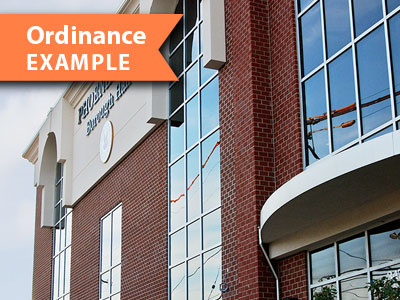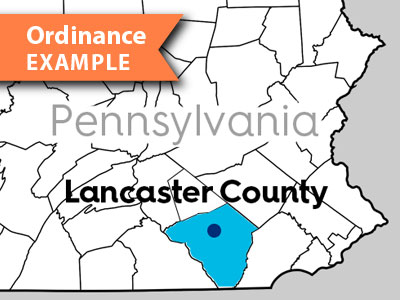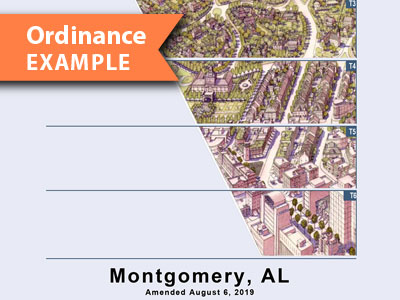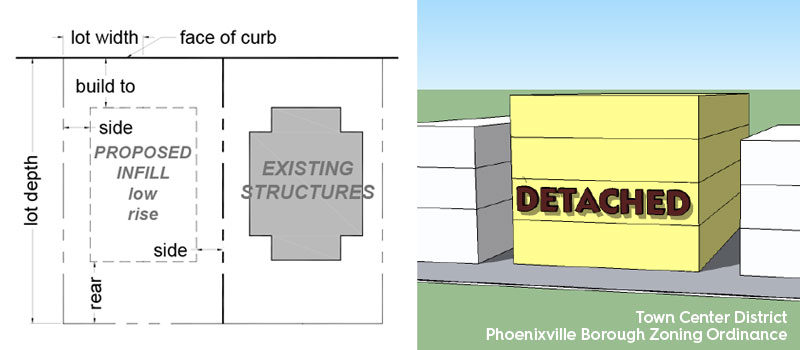
Phoenixville Borough adopted a form-based zoning ordinance. Form-based ordinances focus more on building form and relationship to the public realm (sidewalks, streetscaping, streets) via diagrams and illustrations than more traditional ordinances that rely on area and bulk standards and larger amounts of text.
How it Works
The physical form of our towns and cities affects the quality of our lives and form-based codes have been created to help improve and protect this quality. Whereas traditional zoning ordinances typically emphasize written regulations for specific land uses, separation of land uses, and controlling development intensity through parameters such as dwellings per acre, building setbacks, parking minimums, and floor area ratios, form-based codes primarily stress physical form and urban design expressed through visual diagrams with applied standards or criteria. This approach to regulation recognizes the intrinsic relationship between public areas such as streets and sidewalks with the private realm of homes and buildings.
By recognizing the relationship between public and private space, form-based codes address the interaction, form, and mass of buildings with each other, as well as the scale and types of streets and blocks. Because form-based codes are designed to convey three-dimensional design concepts, the code’s regulations and standards are illustrated and presented in diagrams, cross sections, and other visual depictions, with limited text as required to provide description or direction. To ensure that an overall coherent design is achieved, these codes are linked to a community plan and vision.
Form-based codes often reflect and complement the traditional design fabric of a neighborhood, corridor, or specific area, encourage a less automobile-dependent development pattern, and prioritize pedestrian and bicycle facilities. Form-based codes may also result in developments that reflect a particular aesthetic character.
Form-based codes are primarily implemented through the municipal zoning ordinance and address land use (type of use such as residential or commercial), the physical form (building heights, setbacks), and design standards (for specific individual uses, sidewalk requirements and widths, parking requirements, etc.) of the land and/or buildings.
Benefits
Developed Through Extensive Public Participation
Form-based codes are typically developed using visioning sessions and public design charrettes emphasizing significant input from residents and business owners for buy-in and to ensure the code is representative of the specific location and an established future vision for the area of application.
Reinforces a Neighborhood's Vernacular Architecture
Form-based codes contribute to preserving a "sense of place" as well as guiding compatible in-fill development or redevelopment.
Supports Compatibility with Historic Areas
Form-based codes can result in development that is more compatible with the historic nature of a community by respecting the size and scale of existing historic resources.
Achieves a Predictable Physical Result
Because they are prescriptive, provide clear easily understood illustrations, and are developed through a comprehensive community based approach, the intent and final result of their implementation is more predictable.
Neighborhood Development
Form-based codes promote energy conservation by using land efficiently, reducing energy use, and conserving future energy use by reducing the reliance on individual automobiles, particularly for the non-driving population.
Encourages Development in Growth Areas with Appropriate Infrastructure
Form-based codes support and encourage development appropriate for growth areas thus reducing development pressure in resource protection or "greenfield" areas.
Can be Paired with Transferable Development Rights Programs
Form-based codes can be used in conjunction with TDR programs to direct growth into areas better served by infrastructure ("receiving" areas) while protecting land in greenfield "sending" areas.
Developing a form-based code requires determining the areas where the code will apply. The code could encompass an entire municipality or be limited to a specific zoning district or corridor. Careful inventory and analysis of the type and forms of buildings in the various transects is required to write a code that maintains and enhances existing architecture.
Get Started
A municipality should consider how form-based codes will be applied (entire ordinance, a district, or corridor) prior to moving forward with the process. Form-based codes may be developed for an entire zoning ordinance, for a specific zoning district, or as an overlay zone for certain blocks or corridors. Some municipalities prefer to “try out” or “dip their feet” into form-based codes by generating a code along a main street or a town center district prior to undertaking an entire form-based code ordinance. These districts typically already have design standards, historic resource protection ordinances, or other standards or design guidelines which can be translated into or inform the development of a form-based code (district).
Policy support for the use of form-based codes including where they are most appropriately used should be incorporated into the municipal comprehensive plan. The municipal planning commission, staff (zoning, codes, or building officer, engineer, or planner), and/or consultants (planning consultants, county planning staff, solicitor) should be engaged to discuss potential use of form-based codes and educate all parties regarding the pros and cons, process, and administration of form-based codes prior to moving forward.
The implementation of form-based codes are required to comply with the process outlined for zoning ordinances by the Pennsylvania Municipalities Planning Code (MPC) Act 247. Due to the more visual aspects of a form-based code, use of visioning sessions, visual preference surveys, and design charrettes are recommended throughout the process of developing form-based codes to gain input from stakeholders (residents, business owners, etc.) and provide information and education regarding the process.
Form-based codes typically include the following elements:
Definitions
Technical terms are defined.
Regulating Plan
A map of the area designates the locations where overall building massing and form-based standards apply, based on community expressions of the physical character of the area. The Regulating Plan could be a part of, in addition to, or as a replacement of the Zoning Map depending on the method of implementation.
Block Standards
Regulations generally control developments over a certain size and enforce standards for street patterns such as minimum and maximum block lengths, street connectivity, requirements for alleys, and allowing or not allowing cul-de-sacs.
Frontage Type Standards
Regulations control the way buildings engage the public realm such as frontages having a common yard, porch and fence, terrace or courtyard, stoop, storefront and awning, gallery, or arcade.
Building Form Standards
Regulations control the placement (setbacks and lot dimensions), form (building heights, width, and depth), parking, permitted use, permitted frontage types, and permitted building types.
Building Type Standards
Regulations control the location of and dimensions for different building types such as single family detached, twins, carriage house, townhouse, apartment, live-work, commercial block, or linear buildings. Standards may also control entrance location, pedestrian access, interior circulation, frontages, access to parking, location of services (utilities), and open space requirements.
Architectural Standards
Standards for external architectural materials and quality are provided such as façade composition, windows and doors, elements and details (eaves, porches, bay windows), and building materials (siding, roofing). A “design palette” containing photographic examples of desired design elements is often included.
Public Space Standards
Specifications are established for the elements that comprise the public realm including civic spaces and thoroughfares (within the right-of-way). Civic spaces include parks, plazas, and similar areas and include requirements for acreage, location, size (dimensions), activity, and character (natural, urban, greenspace, hardscapes). Thoroughfares include regulations by type such as movement type, design speed, lane widths, bicycle lanes, parking lanes, curb types, landscaping, walkway types (sidewalks), lighting, distance between intersections, crosswalks, and similar details.
Code Administration
Includes project review and approval, roles, rules, and additional standards such as nonconformities.
Considerations
Coordinated Planning
Form-based codes are best implemented with a single, master, coordinated plan that reflects widespread municipal support. The method of developing and implementing of form-based codes should be carefully researched in advance and the process carefully laid out.
Educational Component of Implementation
Form-based codes are likely relatively unfamiliar to municipal officials requiring an educational component prior to moving forward with implementation. Code enforcement officers may require additional training in applying the ordinance. Matching the character of existing development after the use is built can be challenging to enforce.
Appropriate Location
The use of form-based codes is typically most appropriate in urban areas and other places of higher intensity uses.
Significant Upfront Input Required
The level of intensity for developing form-based codes may be more than required for a traditional zoning ordinance with regard to the number of professionals interviewed or consulted during the process, public visioning sessions, the number of charrettes and public input required, the amount of field work required, and public meetings to review, refine, and adopt the code.
Public Acceptance
Public acceptance of a compact, mixed land use pattern that may be part of form-based codes could encounter pushback from residents. This consideration makes the public input component a particularly important part of the planning process.
Cost Considerations
Form-based codes are likely to require significant revisions to municipal land use ordinances and the cost of developing the codes could exceed that of more traditional zoning types. However, these costs may be minimized by starting with one district, a corridor, or an overlay.
Examples

Phoenixville Borough is the primary Chester County example for form-based codes.

Narberth Borough, Montgomery County, PA adopted a form-based code in 2016.

Lititz Borough, Lancaster County, PA.
Form-based codes

The City of Leander (Texas) uses a Smartcode structure originally developed by Duany Plater-Zyberk & Company.

The City of Montgomery (Alabama) also uses a Smartcode.

The City of Benicia (California) Downtown Master Plan and form-based code (2007) using Opticos Design, Inc., Berkeley, California.



